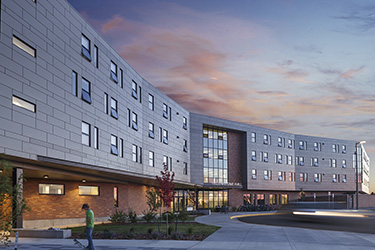|
Subscribe / Renew |
|
|
Contact Us |
|
| ► Subscribe to our Free Weekly Newsletter | |
| home | Welcome, sign in or click here to subscribe. | login |
Architecture & Engineering
| |
 |
October 26, 2017
Surveys: NAC Architecture
Specialty: Creating places that advance learning, enhance wellness and enrich lives
Management: Kevin Flanagan, managing principal of the Seattle office; Dana Harbaugh, CEO
Founded: 1960
Headquarters: Spokane
2016 revenues: $46 million
Projected 2017 revenues: $46 million
Projects: Mount Si High School replacement for Snoqualmie Valley School District, Snoqualmie; PeaceHealth Ketchikan Medical Center, Alaska; Yellowstone Hall, Montana State University, Bozeman
Kevin Flanagan, managing principal, answered questions about his firm.
Q: NAC is acclaimed for its school designs. What’s the buzz about your recent Hazel Wolf school project?
A: As a pioneer in Environmental STEM (E-STEM) education, Hazel Wolf K-8 E-STEM School is a case study for outdoor learning on a tight urban site. The site is conceived as a lab with a variety of indoor/outdoor learning areas. Every inch of land is used, including extending the central courtyard up and over the main office and the created wetland/pond, which mirrors the local Thornton Creek watershed. Visual connections across the building and site foster students’ excitement through seeing learning in action.
Q: Mount Si High has advances in security and safety. How are they important?
A: During the design of Mount Si High School, NAC studied security and safety in four categories: natural disaster, dangerous intruders, student-to-student, and personal well-being.
As the school is in a flood zone and a liquefaction zone, special accommodations were made to the building design to address natural disaster concerns beyond those commonly required at schools. Approximately 4,000 stone columns secure the subgrade from liquefaction, and the building is elevated on plinths to protect it from flooding (and not damming water to flood adjacent property owners).
MSHS was able to take advantage of the design elements for natural disasters and use them for protection from intruders too. The elevated plinth for the floodway gives added supervision and control for approaching visitors.
Q: What tech is in the LEED gold Yellowstone Hall at MSU?
A: Montana State University stakeholders were passionate about solar access and daylighting. The shape of the building was largely driven by ensuring solar access on all sides. The elongated east/west form creates a “sun mitt” to enhance solar gain during the colder seasons. Solar panels heat water for the building and sun shading mitigates summer sun.
Q: How is your collaborative program ”Hack Your Classroom” doing?
A: In the spring of 2017 a national campaign was launched aimed at crowd-sourcing information. We asked teachers across the country how they have adapted their learning spaces to meet current needs to improve the learning experience. For us, the winning “hack” solved a clear spatial problem while involving a diverse group of stakeholders, including students.
Q: Which medical projects are emblematic of NAC’s design philosophies?
A: PeaceHealth Ketchikan Medical Center, Kootenai Health, and Spokane Teaching Health Clinic are all exemplary examples of recent medical facilities representative of our firm’s design philosophies.
Q: Which sector of your firm’s work has grown the most in recent years?
A: Both our education and healthcare markets have grown significantly in recent years. In education, there appears to have been some pent-up demand for projects coming out of the recession and the renewed public support to pass construction bonds in K-12 school districts. We have seen an increase in demand for behavioral health facilities in our healthcare practice, two project types for which we have a deeper portfolio.
Other Stories:
- Ice Box Challenge: a cool test of Passive House
- Survey: Code Unlimited
- Survey: IA Interior Architects
- Survey: AHBL
- Survey: Lemons Architecture
- Is growth only benefiting a small segment in Seattle?
- Rock wool’s new role: protecting exterior wood stud walls
- Get ready for the new year — and new energy codes
- After 10-year engagement, Kinects inverts ‘wedding cake’
- WSU cultural center: ‘How are you going to build this?’
- High-performance building? Start with early design analysis
- How ‘affordable’ housing is disappearing in Seattle
- How long will your AV last? Consider your cell phone
- Survey: Arup



